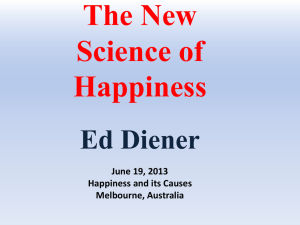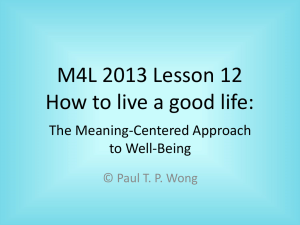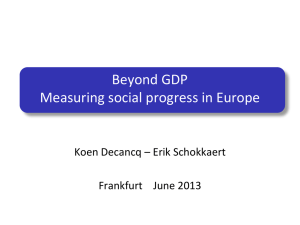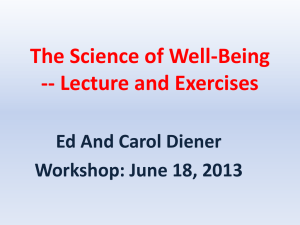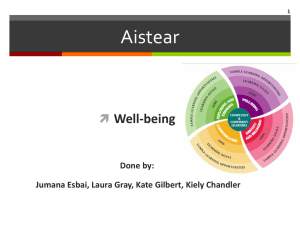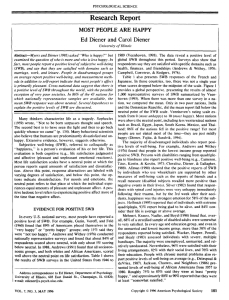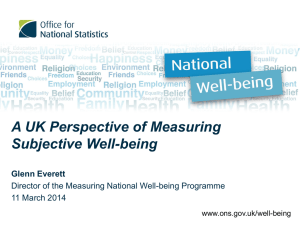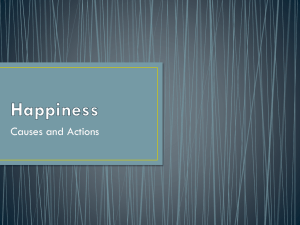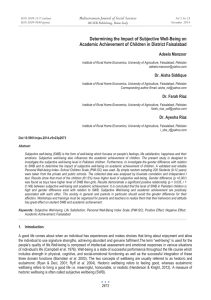Lecture_on_scales_and_measurement_without_photos
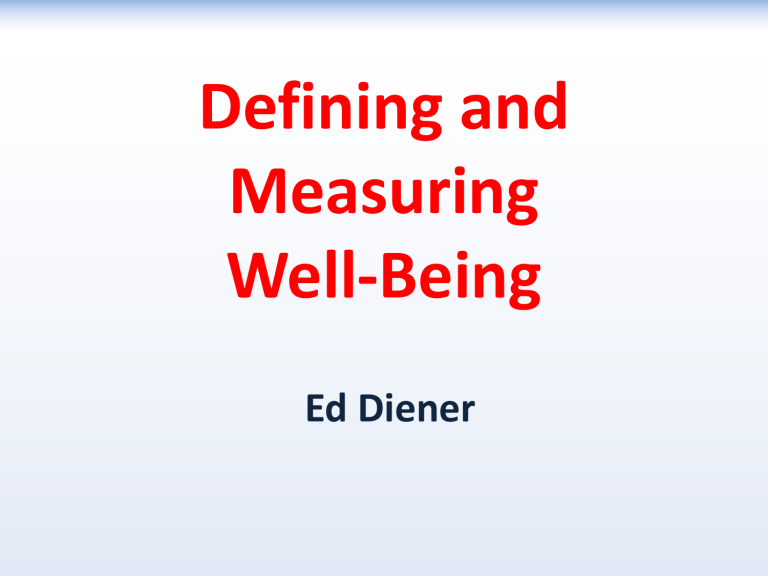
Defining and
Measuring
Well-Being
Ed Diener
Complete the Scales Now.
If You Have Not Finished, You
Can Complete
Them at Home
(6 pages; stop when you get to
Scoring Instructions)
History: What is Happiness?
What is Well-Being?
Greek Philosophers
Hedonists, Epicureans
Utilitarians: Bentham
Aristotle (Eudaimonia)
Diener’s empirical approach
SWB
Eudaimonia
Types of Subjective Well-Being
Positive Affect
Negative Affect
Life Satisfaction
Satisfaction with Domains
(e.g., health, work, marriage)
Separation of SWB
• Life satisfaction
With life and domains of life
• Positive Feelings
Joy, enjoyment, love, awe, etc.
• Low Negative Feelings
Anger, depression, anxiety, envy, guilt
Can We Measure SWB with
Just One Number?
• Not completely, no
• Life satisfaction – material well-being
• Positive affect – social well-being
• Negative affect – personality, conflicts
The Summum Bonum?
• Happiness is everything
– The reason we seek all other goals
– When we have it, we need nothing else
Is SWB the
Summum Bonum?
Methods to Assess
Subjective Well-Being
• Self-report surveys: How satisfied are you?
• Family and friends
• Smiling, laughing
• Biological indicators
• Cognitive measures (e.g., memory)
These CONVERGE!
Self-reports
Experience
Sampling
Informant
Reports
Biological
Measures
Objective
Behavior
Memory and RT
Issue 1: Are SWB Measures Valid?
SWB
Interview
Are The Measures Valid?
Yes!
They correlate with each other
They predict future behavior
Not perfect, but pretty good
Grade: B
Discussion
• Current mood influenced your score?
• Global biases – some positive, some not?
• Valid for you?
Eudaimonic Theories
• Living a meaningful life; living in accord with human nature
Carol Ryff
Deci and Ryan
Martin Seligman -- PERMA
“Eudaimonic” Theories
Self-Determination Theory
• Ed Deci and Richard Ryan
• Competence
• Autonomy
• Relatedness
Carol Ryff
• Purpose
• Mastery
• Self-acceptance
• Autonomy
• Personal growth
• Positive relationships
PERMA (Seligman)
• Pleasure
• Engagement (e.g., Flow)
• Relationships
• Meaning
• Achievement
Empirical Relations Eudaimonic and
Subjective Forms of Well-Being e_r
.41
.85
e1
Relationship
.64
.66
.69
.76
-.58
.77
Support
.43
Community
.47
Trust
.58
Respect
.33
Loneliness
.59
e2 e3 e4 e5
.92
e6 e_m
Well-being
.95
.94
Mastery e_s
SWB
.91
.89
.77
.78
.65
-.23
.78
.84
Flow
.61
Skill
.42
Learning
.06
Control
.60
Efficacy
.71
Worth
.67
.82
.88
.88
.89
.88
-.28
Achievement
.77
Meaning
.77
Optimism
LS
PA
.79
.78
.08
NA e7 e8 e9 e10 e11 e12 e13 e14 e15 e16 e17 e18
.46
.46
.48
Diener: Sustainable Happiness
• The so-called Eudaimonic forms of well-being are important because they can create longterm subjective well-being
• People cannot just seek pleasures to stay happy
• People need long-term goals
Purpose and Meaning
• People need others
• People enjoy mastery and flow
Sustainable Happiness: Meaning
Useful Fiction
Although SWB and eudaimonia are not so separate as some would have us believe, it is useful to consider eudaimonia as valuable in itself because it can create long-term happiness for humans. These are things we need to be happy and to make others happy.
Discussion
Important?
Different?
•
Subjective well-being
•
Psychological well-being
•
Quality of life
•
Eudaimonia
Why Measure Well-Being?
• To help people see where they are strong vs. need improvement
• To guide policy
• To use in scientific study
• People attend to what is measured
Conclusions
• There are several types of SWB
• There are additional types of eudaimonic happiness
• All these comprise psychological well-being
• The self-report measures are reasonably valid
• The measures have several useful purposes
• Eudaimonia might be an approach to sustainable happiness
Diener’s scales measure the various forms of well-being
– PA, NA, Life satisfaction
– Mastery, achievement
– Meaning and purpose]
– Etc.
SCORING
Reversing Negative Items
3 items on page 1
13, 14, 15
3 items on page 2
28, 29, 30
Subtract your answer from 6
Overview of Scale Scoring
– Adding up subscales
Page 1,
Page 2,
Each section on Page 3, etc.
– But first reversing six items
Scoring
• Page 1 – add 18 items (after reversing)
• Page 2 – add Add 21 items
Scale Norms
• Page 1 – 18 items = Relationships Scale
• Page 2 – 21 items = Mastery & Engagement
• Page 3 – 3 items (40-42) Meaning/Purpose
• Page 3 – 3 items (43-45) Optimism
• Page 3 – 3 items (46-48) Life Satisfaction
• Page 3 – 3 items (49-51) Positive Feelings
• Page 3 – 3 items (52-54) Negative Feelings
Page 4
• Flourishing Scale (8 items)
– Add 55 – 63
• Satisfaction with life scale (5 items)
– Add 63 – 67
• SPANE Positive Experience (6 items)
– Add 68, 70, 72, 74, 77, 79
• SPANE Negative Experience (6 items)
– Add 69, 71, 73, 75, 76, 78
Thriving Scale
Brief Psychological Well-Being Scale
(10 items)
• Add items 3, 16, 20, 31, 34, 37, 40, 43,
48, and 51
Cantril’s Ladder – just whatever numbered step you are on is your score
• Now you can move your scores to the Scales NORMS pages. Each score next to the appropriate scale, and you can circle the norm description that describes your score.
Your Profile of Well-Being
Relationships
Mastery/Engagement
Meaning/Purpose
SWB
Optimism
Life Satisfaction
Positive Experience
Negative Experience
Flourishing Scale
Brief Psychological Well-Being Scale (Thriving)
SWLS (Life satisfaction)
SPANE Positive experience
SPANE Negative experience
Cantril’s Scale (Ladder)
Discussion
• How do you feel about the scales?
Reactions, responses?
• Is your Eudaimonia different from your SWB?
